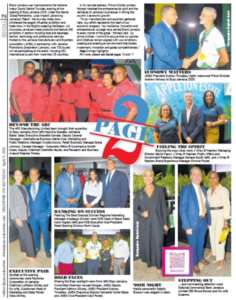Wine-tasting notes
We are exactly two weeks away from the Jamaica Observer Food Awards and remain on a quest to find out what Jamaica’s favourite wines are. But let’s pause a while to reflect on just how we choose a wine from off the shelf. Do we take into consideration the wine-tasting notes on the back of the label?
A. Toad Creek Winery intertwines zesty rose midtones and a flippant sawdust perfume in their 2002 Red Zinfandel.
B. A soapy Brussels sprout aroma and embittered macadamia nut midtones are blended in the 1952 Chenin Blanc from Cedar Valley Vineyards.
C. Classic and harmonious, a very solid Napa 100% Cabernet that’s dry and firmly tannic in the mouth. Feels balanced, harmonious, age-worthy, a wine without seams or faults. Fruity, but not overly so, with the blackberries and black currants generously balanced by herbs, minerals and cedar.
Can you guess which of the above is the real wine-tasting note?
The truth is that two of these tasting notes are ‘fake’ tasting notes produced by a website called Wine Review Generator. They describe themselves as “The world’s definitive database of wine reviews. The search interface isn’t super-convenient, but keep hitting the button and you should eventually get to the particular wine that you’re interested in. Your tastes may differ from the reviewer’s.” Tasting note “C” is a real tasting for a wonderful wine I had recently called Hestan Vineyards “Stephanie” Napa Valley Cabernet Sauvignon 2006. International wine periodical Wine Enthusiast scored this wine 96 points and it was #44 on their list of Top 100 Wines of 2010. Would you have bought this wine based on this tasting note?
Some of the wine descriptions include reference to fruits that most of us have never heard of, much less tasted. Generally, a person standing in the supermarket aisle wants to know if the wine is either sweet or dry and the level of this sweetness or how dry. Some want to know if the wine is ‘Oaky’, others want a red wine that is not “too bitter” . In other words, the majority of wine buyers generally want a simpler description instead of the poetic descriptions that sometimes grace the back of the bottles.
In some markets where wine appreciation and thus wine purchase is growing, there have been some attempts to simplify the selection process by grouping wines in style categories to make the purchasing decisions reasonably easy. These categories typically are: (1) Sweet or slightly sweet wines; (2) dry, light-body white wines with little or no oak (3) dry, medium to full-body white wines with oak; (4) Light-body, low-tannin red wines; (5) medium to full-body red wines (6) sparkling wines.
Internationally, some supermarket chains have come up with notes that are simple and easy to understand. One British writer recently suggested tempered use of fruit descriptors combined with those more broad terms — or simply replacing words like “citrus” with “fresh” and “zesty” to come up with a middle ground. Not everyone agrees; what are your thoughts?
Chris Reckord – entrepreneur and wine enthusiast. Send your questions and comments to creckord@gmail.com. Follow us on Twitter: @DeVineWines @Reckord















